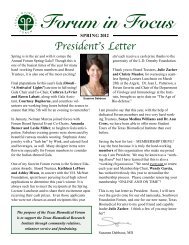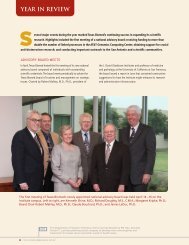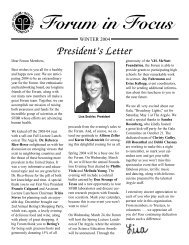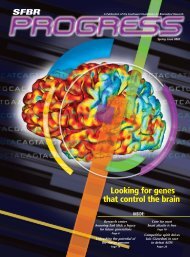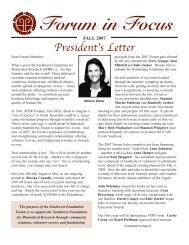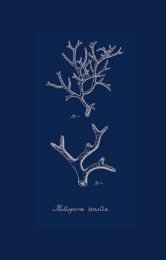SNPRC ROUNDTABLE - Texas Biomedical Research Institute
SNPRC ROUNDTABLE - Texas Biomedical Research Institute
SNPRC ROUNDTABLE - Texas Biomedical Research Institute
You also want an ePaper? Increase the reach of your titles
YUMPU automatically turns print PDFs into web optimized ePapers that Google loves.
<strong>SNPRC</strong> roundtable<strong>Research</strong> at <strong>Texas</strong> Biomed’s Southwest National Primate <strong>Research</strong> Center(<strong>SNPRC</strong>) offers great promise for understanding and treating infectiousdiseases and identifying the genetic components of susceptibility to commondiseases of public health importance. Much of this workis aided by the <strong>SNPRC</strong>’s pedigreed baboons and coloniesOF chimpanzees, rhesus monkeys,and other species. For thisroundtable discussion, annualreport editor Joseph Careyinterviewed four <strong>Texas</strong> Biomedscientists closely involvedin <strong>SNPRC</strong> research.THE SCIENTISTS are (left to right): Robert E. Lanford, Ph.D., in the Department of Virology and Immunology;Thomas Folks, Ph.D., <strong>SNPRC</strong>’s associate director for <strong>Research</strong> Resources; AND Lorena M. Havill, Ph.D., and AnthonyComuzzie, Ph.D., in the Department of Genetics.<strong>Texas</strong> Biomed 2011 Annual Report13
<strong>SNPRC</strong> roundtable“During the last10 years, we havefocused on testingnew therapies forhepatitis C that havebeen developed bypharmaceuticalcompanies. This has ledto the developmentof antiviral cocktails,multiple differentdrugs given togetherto cure hepatitis C,some of which havebeen tested here.”— Robert Lanford, Ph.D.Q: Dr. Lanford, you have beeninvolved in primate center-relatedresearch projects for the 28 years thatyou have been at <strong>Texas</strong> Biomed. Pleasedescribe your current focus of research,important f indings, and where you seeit headed in the near future.Robert Lanford: Today hepatitis C virus(HCV) infection, which is chronic in about 4million Americans, is the number one causeof liver transplantation and the most rapidlyincreasing cause of death from liver cancerin the United States. During the last 10 years,we have focused on testing new therapiesfor hepatitis C that have been developedby pharmaceutical companies. This has ledto the development of antiviral cocktails,multiple different drugs given together tocure hepatitis C, some of which have beentested here. With hepatitis C, we knew wewould eventually come up with a cure, andthat occurred in 2011, much sooner than wethought. A number of companies now havecocktails in clinical trials that cure most HCVinfections in less than 12 weeks without usingthe really harsh therapy known as interferon.This breakthrough is due to the efforts of thescientific community and animal models, suchas the chimpanzee.The next thing is to develop a vaccine, andsome are going into human trials right now.If we are fortunate, some of those vaccineswill be effective. Several of them have alreadybeen tested in chimpanzees and have shownsome promise, but there are still failures. Wereally don’t have good markers for what goeswrong when the immune system fails and whyit fails. Some immune and gene expressiontechnologies are allowing us to probe furtherinto that.In one of our new programs just funded bythe National <strong>Institute</strong>s of Health (NIH), we areusing something called antisense technologyto knock down the expression of specific genesinvolved in the innate immune response ofthe marmoset to determine which genes arecritical for preventing chronic infections. Thisis the first time gene knockdown has beenperformed in a systematic manner in a primate.If successful, we believe this model can beused to study other diseases and to identifyspecific genes that may be therapeutic targets.Q: What are some of the other researchprograms in the department?Robert Lanford: Ricardo Carrion and JeanPatterson have developed the marmoset as amodel for infection with the Ebola and Marburgviruses, which cause hemorrhagic fever. RobertDavey is using viral-like proteins to understandthe cellular pathways that are required forinfection by these hemorrhagic fever virusesand is screening small molecules to block theseinfections. (See article on biodefense, page 24.)Both Marie-Claire Gauduin and Luis Giavedoniwork on simian immunodeficiency virus (SIV),the primate model of HIV infection. Theirstrategy is to make SIV vaccines that work inanimals and then recast them to work as HIVvaccines in humans.Q: Any idea when some of these vaccinesmay get to the FDA for approval?THOMAS FOLKS: Probably not until the latterpart of this decade. More and more work isgoing to be needed in the monkey modelbecause testing in enough humans to getreliable results is going to be very hard toafford. So, you are really relying on the animalmodel to be your first attempt to see if avaccine is efficacious.ANTHONY COMUZZIE: It’s always importantto reiterate that biology is messy, and yet thisnaïve opinion is out there that you can replacea whole organism with some sort of statisticalmodel or cells in a petri dish. They can neverreplace the complexity of a living organism.Q: Dr. Comuzzie, you are working onobesity and diabetes. Please describeyour major focus on these disorders.ANTHONY COMUZZIE: In my 20 years here, wehave seen that cardiovascular disease, obesity,diabetes, and hypertension are all incredibly14 <strong>Texas</strong> Biomed 2011 Annual Report
interrelated. So you can’t really do work onone of these conditions without having to becognizant of work with some of the others.I evenly split my efforts between nonhumanprimates and human populations, and thisallows me to work in a translational paradigm.For example, with the things we find in humangenes, we can go back and look at nonhumanprimate models. Or we can control aspects ofthe environment of the baboon that we can’tcontrol in humans.In the last decade, we have increased ourstudy of physiology because it’s very difficultto focus just on the genetics when we reallydon’t understand all the physiology. Oneof the things we are trying to do in parallelbetween our human studies and nonhumanprimate studies is to map genes that regulatesusceptibility. These conditions are complex,and they are not simply genetic in origin. Thereare also very important environmental triggers,such as diet.You can’t change a person’s genetics,but you may be able to modify aspects ofthe environment or, perhaps even moreimportantly, manipulate the environmentalong with understanding the geneticunderpinning so that you can get the mosteffective types of treatment.with the nutritional composition of thetypical American diet by adding in simplecarbohydrates. This is allowing us to identifyadditional genetic pathways involved in themetabolism of both fat and carbs, and eventhe sort of synergistic interaction between thecarbs and fat in the diet.Q: Dr. Havill, please tell us aboutthe value of the baboon colony inyour research on osteoporosis andosteoarthritis.LORENA HAVILL: I came to San Antonio 10years ago because of the value I saw in thebaboon for studying two age-related diseasesof the bones and joints: osteoporosis andosteoarthritis. Simply put, to get good answersabout how these diseases start and progress,we need to study animals that develop themnaturally the way humans do. Other readilyavailable animal models (mice and rats) justaren’t susceptible to these age-related skeletaldisorders.Q: Please describe some of your currentprojects, results, and what you seehappening over the next few years.LORENA HAVILL: In osteoporosis, mycollaborators and I are working on ways toget a better picture of what puts some peopleat higher risk for breaking a bone. This work,funded by the NIH, could revolutionize theway we view bone strength. Doctors evaluateyour risk of breaking a bone by doing a bonescan to see how dense your bones are. Currentmedical thinking is that the denser the bone,the less likely it is to break. The problem isthat roughly half of the people who break abone actually pass the bone density test. Iam working with engineers at the Southwest<strong>Research</strong> <strong>Institute</strong> to identify other factors—arrangement of bone tissue, mineral andchemical properties, for example—“this naïve opinionis out there that youcan replace a wholeorganism with somesort of statisticalDuring the last five years, we have begunto think about the modern American diet asnot just high in fat, but also high in simplecarbohydrates. There is growing evidence thatwhile fat may be a component of the dietthat induces the damage to vasculature andleads to these other metabolic disruptions,it’s not sufficient in itself to do that. Forour nonhuman primate studies, we havedeveloped a diet that’s more in keepingmodel or cells in a petridish. They can neverreplace the complexityof a living organism.”— Anthony comuzzie, Ph.D.<strong>Texas</strong> Biomed 2011 Annual Report15
When we became a national primate researchcenter, with that came the obligation to involve moreoutside people and services ranging across all species.will also move to the new building along witha very new and sophisticated biosafety level 3flow cytometry facility. This is going to help witha lot of the work we do in HIV and SIV.Q: What will be the impact of the recent<strong>Institute</strong> of Medicine (IOM) reportlimiting chimpanzee research and theNIH response?ROBERT LANFORD: The three criteria used by theIOM committee to justify chimpanzee researchare the same criteria we’ve always used. Therecent report has accelerated something thatwas in the plan anyway.It is premature to limit chimpanzee research,however. Today we do not yet have an HCVvaccine, and there are some things on thehorizon that involve chimpanzees — such asstudying the very complex process of alteringthe immune response in people that haveautoimmune diseases that cause type I diabetesand rheumatoid arthritis.ANTHONY COMUZZIE: A two-edged swordis in play. One of them is you don’t want touse an animal model that is more than youneed. If a rodent really will work, then youshould work with a rodent. At the same time,if rodents, dogs, or any other animals are notgoing to give you a viable usable answer, youshouldn’t use them. If you can do it withoutusing chimpanzees, that’s a good thing. Yetthere is a very real political agenda comingfrom individuals whose ultimate goal is tostop animal-based biomedical research. So it isimportant to us as a community of investigatorsto make the public aware of the fact that weunderstand and appreciate this issue and thatwe use chimpanzees only because there is realvalue to be gained.THOMAS FOLKS: A moratorium on chimpanzeesin biomedical research was not recommendedby the IOM committee. The chimpanzee is stillavailable for tests where it is the only animalwe could use. But the bigger question now iswhether attempts will be made to limit researchwith other species.Q: Looking to the future, are there anyareas of research where the primatecenter could expand to maintainits viability?ROBERT LANFORD: We need to develop morebiologics, drugs, and vaccines made fromliving organisms. We have tested biologics inchimpanzees to see whether or not they arehaving the intended function. The argument forusing other species is valid, and so we can nowengineer all of these biologics so that they havethe same reactivity in a baboon or macaquemonkey as they do in humans. There is also abig opportunity in small molecules that is goingto impinge on these very complex diseases.THOMAS FOLKS: The whole translationalresearch concept will increasingly involveregeneration, personalized medicine, progenitorcell studies, and stem cells. We are looking todevelop programs in these areas during thenext five years.ANTHONY COMUZZIE: The only way personalizedmedicine is going to be developed is byhaving an individual completely characterizedgenetically, and you have to have a goodmedical history to be able to determine whereyou are and where you’re trying to go. The factthat we have these deep pedigrees with thebaboons, going back eight generations, is veryimportant. With the whole baboon sequenceshortly to be available, we’ve got a place tofield-test the whole concept in a way that wecouldn’t effectively do in humans.THOMAS FOLKS: Medicine is going in a lotof different directions, and the effect ofenvironmental factors on the genetics ofdisease is going to be very important. It’s likeyou have a ramp on the table here and you puta marble on it, and let it roll off. Do it more thanonce, and the marble rolls off differently eachtime. Why is that? Genetics is exactly the same.And that’s one reason why we’ve got so muchmore work to do.“Medicine is goingin a lot of differentdirections, andthe effect ofenvironmentalfactors on thegenetics of diseaseis going to bevery important.”— THOMAS FOLKS, Ph.D.<strong>Texas</strong> Biomed 2011 Annual Report 15 17



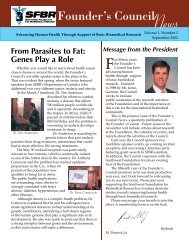
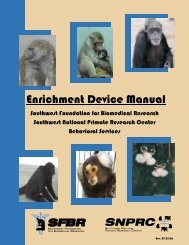
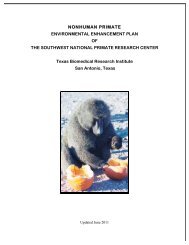
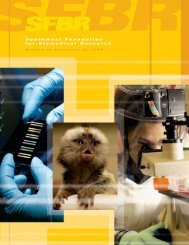
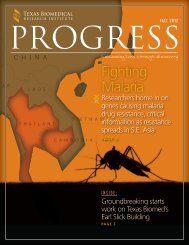
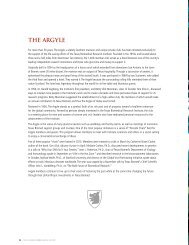
![Vol. 8 No. 2, 2011 [PDF] - Texas Biomedical Research Institute](https://img.yumpu.com/35688099/1/190x245/vol-8-no-2-2011-pdf-texas-biomedical-research-institute.jpg?quality=85)
